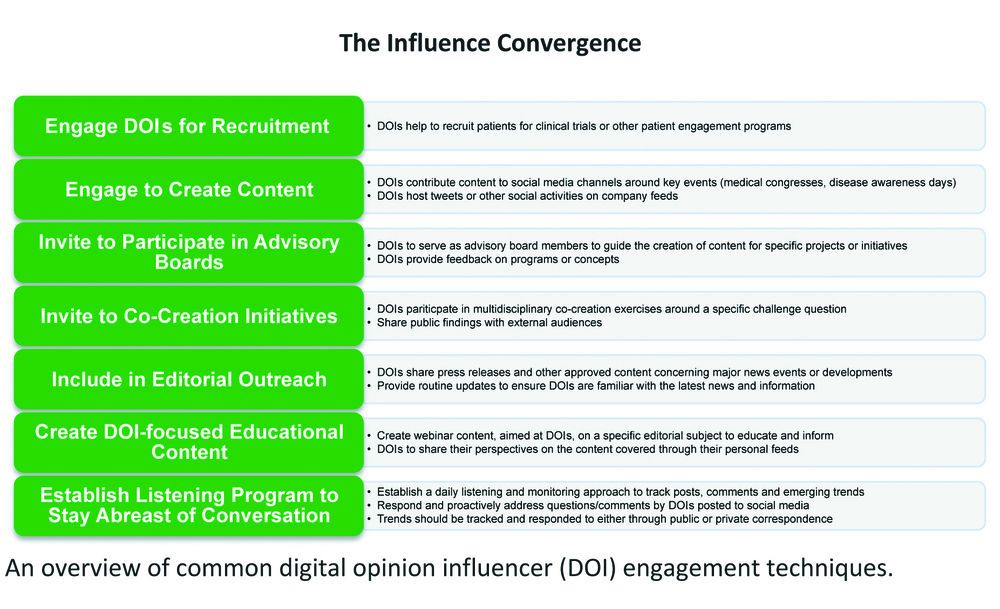Beyond KOL Marketing: Tapping Digital Opinion Influencers
Pharmaceutical Executive
With healthcare professionals and patients now collecting much of their information online, there is new opportunity for “digital opinion influencers” to amplify traditional KOL messaging-or create their own.
Pharmaceutical companies have long recognized the power of key opinion leaders (KOLs) in driving influence through traditional channels: journals, speaking events and word of mouth. The problem, however, is that healthcare providers (HCPs) and patients are acquiring information about disease and treatment in the online world-and many KOLs are not “digital opinion influencers,” or DOIs. This creates an opportunity-strategic DOI identification, outreach and management-for brand, communications and medical teams that is often overlooked or poorly addressed.
Sizing the opportunity
This opportunity is largest for pharmaceutical companies providing drugs to address chronic conditions to active patient communities, in which there are high levels of treatment innovation. For example, The Stem recently conducted a study for a pharma client to analyze the healthcare provider DOI community across seven markets for a chronic condition. The results were notable. Of 4,000 HCPs in the community, we identified 1,400 active posters who posted at least three times in the past year. And of these, we identified 131 influencers driving the lion’s share of influence. Interestingly, more than a quarter of these were not traditional KOLs already on the client’s radar. Further, we discovered active posters regularly reached an aggregate audience of approximately 2.8 million followers and fans, many of whom were strategically important prescribers, patient prospects and payer influencers.
This example illustrates the potential power of managing relationships with a small number of DOIs, who act as a force multiplier for life sciences peer-influence programs. A traditional KOL may have influence in terms of the articles written or the conferences at which they speak, but a DOI has an outsized reach made possible through social media.
Who are DOIs?
Digital opinion influencers are influential members of a health community turned to for advice, opinions and information. Their influence flows from reach (followers), their resonance (content sharing) and relevance (topics discussed). Their distinguishing characteristic (versus traditional KOLs) is their use of social media to either create or amplify messages. DOIs are both medical professionals and non-professionals.
In the medical world, DOIs are typically drawn to social media as a platform for building their reputations. These DOIs share opinions on therapies, discuss presentations from medical congresses and share advice on disease and patient management. Another segment-researchers and academics-frequently communicate models of disease understanding based on the latest studies. These professional DOIs have converged around Twitter as the preferred channel, particularly around major medical conferences, while simultaneously turning to closed HCP platforms for peer-to-peer discussions.

In the patient world, DOIs include patients and caregivers who typically emerge from personal experience-the quest for advice, information or connection-which transforms into a mission. Health bloggers and so-called e-patients (who take an active online role in their health) have amassed large followings, sometimes leveraging their influence to form non-profits, online media companies or patient associations. Traditional patient groups have also joined the fray, seeing new ways to reach audiences. Patient DOIs use a variety of channels (Facebook, Instagram and blogs, to name a few) and are not concentrated in a single medium, such as HCPs with their use of Twitter).
Based on our analyses for a range of pharma customers, we have found that DOIs and KOLs often exist in largely different universes, with little overlap. Typically, fewer than 20% of KOLs will also have a social media presence and just a handful will rank alongside DOIs in terms of online reach. In the patient world, this is to be expected, as many DOIs are individuals as opposed to patient advocacy groups that would already be on a pharmaceutical company’s radar.
Identifying, profiling, and engaging DOIs
The first step in establishing a DOI program is to understand the disease area community of interest.
- How large is the community?
- What is the split between different segments?
- How many are active posters versus passive listeners?
- How many followers do the active posters have?
- What are the different topics being discussed?
- Which channels are used most heavily?
This step provides a robust understanding of the online community and can be used to select topical segments (or “social personae”) of greatest interest.
The second step is to dig deeper into the community to identify those posters who have the most significant and relevant follower reach, and the greatest resonance and relevance of posts. This allows teams to:
- Create rich DOI profiles covering channels, topics, followers, geography, among others.
- Develop network maps to highlight connections between DOIs and followers, which often highlight opportunities to build connections between otherwise separate nodes of a network.
From here, a final list of prioritized DOIs can be selected.
The next step is to formulate an engagement strategy. Unlike promotional marketing, DOI engagement plans must be designed to deliver mutual value. Programs that focus narrowly on brand goals, versus a program that considers both brand and stakeholder goals, will fail. Fortunately, there are many opportunities to advance a pharmaceutical company’s corporate, franchise or brand objectives while addressing community needs.
There are several notable examples of successful DOI outreach. Boehringer Ingelheim, a leading pharmaceutical player in social media, leveraged a DOI relationship by having the expert host a live Twitter chat during a respiratory event congress. BI now regularly participates to encourage DOI commentary, adding value to the discussion. In the patient realm, Medtronic, a medical device company, engages patient DOIs in multiple regions for ongoing campaigns and feedback. Influencers are leveraged for guest editorial, product trials, feedback and education campaigns.
Organizing for success
Engaging DOIs is fundamentally a relationship-building task. Many DOI engagement efforts fail because they are seen as a one-off tactic (such as a blogger summit), versus a sustained relationship-building process.
As such, DOI outreach must be integrated into the relationship-building functions and processes within the organization. The Stem’s most successful clients have integrated HCP DOI management within the global and affiliate medical function and patient DOI management within the patient advocacy or communications function, with strong support from a social media or digital competence center. These companies have taken steps to integrate DOI activity into customer profiles to provide valuable actionable data to front-line sales, medical science liaisons and patient advocacy staff. Furthermore, they have developed new processes for engaging with DOIs in real time and working them in an educational, support, research and advisory capacity.
Enhance the message
Pharmaceutical companies have long ago recognized the power of peer influence in supporting their strategic objectives. A well-planned and supported DOI program offers the potential to amplify those efforts by propagating key messages through social media. It’s not a replacement for traditional KOL marketing, but rather a supplement to it. DOI marketing offers the possibility to build authentic, mutually beneficial relationships with key stakeholders in online communities. This can deliver important advantages to life sciences organization’s in terms of customer insight, brand image and authenticity, and content relevance and engagement.
Gregg Fisher is Managing Partner at The Stem. He can be reached at gfisher@thestem.com. Kevin Michels-Kim is a lead social media analyst at The Stem

The Misinformation Maze: Navigating Public Health in the Digital Age
March 11th 2025Jennifer Butler, chief commercial officer of Pleio, discusses misinformation's threat to public health, where patients are turning for trustworthy health information, the industry's pivot to peer-to-patient strategies to educate patients, and more.
Navigating Distrust: Pharma in the Age of Social Media
February 18th 2025Ian Baer, Founder and CEO of Sooth, discusses how the growing distrust in social media will impact industry marketing strategies and the relationships between pharmaceutical companies and the patients they aim to serve. He also explains dark social, how to combat misinformation, closing the trust gap, and more.